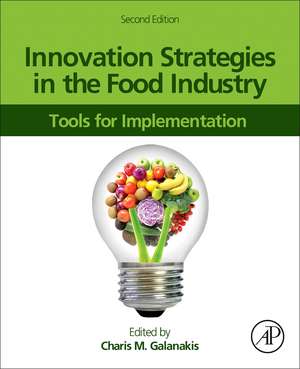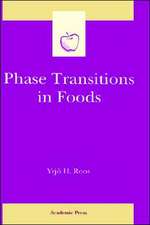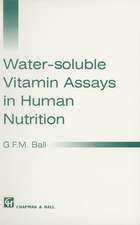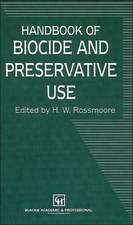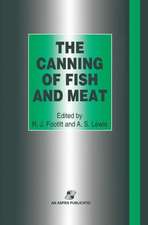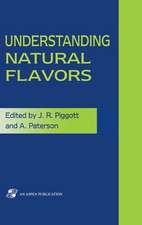Innovation Strategies in the Food Industry: Tools for Implementation
Editat de Charis M. Galanakisen Limba Engleză Paperback – 24 oct 2021
This handbook is ideal for all relevant actors in the food sector (professors, researchers, students and professionals) as well as for anyone dealing with food science and technology, new products development and food industry.
- Includes the latest trend on training requirements for the agro-food industry
- Highlights new technical skills and profiles of modern food scientists and technologists for professional development
- Presents new case studies to support research activities in the food sector, including product and process innovation
- Covers topics on collaboration, entrepreneurship, Big Data and the Internet of Things
| Toate formatele și edițiile | Preț | Express |
|---|---|---|
| Paperback (2) | 643.78 lei 5-7 săpt. | |
| ELSEVIER SCIENCE – 13 iun 2016 | 643.78 lei 5-7 săpt. | |
| ELSEVIER SCIENCE – 24 oct 2021 | 905.88 lei 5-7 săpt. |
Preț: 905.88 lei
Preț vechi: 995.47 lei
-9% Nou
Puncte Express: 1359
Preț estimativ în valută:
173.36€ • 188.24$ • 145.62£
173.36€ • 188.24$ • 145.62£
Carte tipărită la comandă
Livrare economică 15-29 aprilie
Preluare comenzi: 021 569.72.76
Specificații
ISBN-13: 9780323852036
ISBN-10: 0323852033
Pagini: 364
Dimensiuni: 216 x 276 mm
Greutate: 0.85 kg
Ediția:2
Editura: ELSEVIER SCIENCE
ISBN-10: 0323852033
Pagini: 364
Dimensiuni: 216 x 276 mm
Greutate: 0.85 kg
Ediția:2
Editura: ELSEVIER SCIENCE
Public țintă
Primary: Food engineers, foods scientists and nutrition researchers working food applications and food processing as well as those who are interested in the development of innovative products.Secondary: Could be used as a textbook and/or ancillary reading in under-graduates and post-graduate level multi-discipline courses dealing with food science, technology and nutrition, as well as food engineering.
Cuprins
Part A: Innovation Strategies and Long Term R&D for the Food Industry
1. Food Innovation Dynamics and Network Support
2. Open Innovation and Incorporation Between Academia and Food Industry
3. Food SMEs Open Innovation: Opportunities and Challenges
4. Factors affecting the growth of academic oriented spin-offs
5. Transition to a Sustainable Agro-Food System: The Role of Innovation Policies
Part B: Innovation Strategies and Long Term R&D for the Food Industry
6. Innovation in Traditional Food Products: Does It Make Sense?
7. Consumer Driven and Consumer Perceptible Food Innovation
8. Implementation of Emerging Technologies
9. Sustainable strategies in the development of functional foods
10. Openness and cooperation in the food sector
Part C: Cutting Edge innovation areas in the Food Science
11. Innovative Biobased Materials for Packaging Sustainability
12. Development of Functional Foods
13. Food Use for Social Innovation by Optimizing Food Waste Recovery Strategies
14. Adoption of ICT Innovations in the Agri-Food Sector: An Analysis of French and Spanish Industries
15. Implementation of Foodomics in the Food Industry
16. Future Skills Requirements of the Food Sector Emerging with Industry 4.0
17. Internet of Things in Food Industry
Part D: Conclusions and Perspectives
18. Consumer Acceptance of Novel Foods
19. Challenges and Opportunities
1. Food Innovation Dynamics and Network Support
2. Open Innovation and Incorporation Between Academia and Food Industry
3. Food SMEs Open Innovation: Opportunities and Challenges
4. Factors affecting the growth of academic oriented spin-offs
5. Transition to a Sustainable Agro-Food System: The Role of Innovation Policies
Part B: Innovation Strategies and Long Term R&D for the Food Industry
6. Innovation in Traditional Food Products: Does It Make Sense?
7. Consumer Driven and Consumer Perceptible Food Innovation
8. Implementation of Emerging Technologies
9. Sustainable strategies in the development of functional foods
10. Openness and cooperation in the food sector
Part C: Cutting Edge innovation areas in the Food Science
11. Innovative Biobased Materials for Packaging Sustainability
12. Development of Functional Foods
13. Food Use for Social Innovation by Optimizing Food Waste Recovery Strategies
14. Adoption of ICT Innovations in the Agri-Food Sector: An Analysis of French and Spanish Industries
15. Implementation of Foodomics in the Food Industry
16. Future Skills Requirements of the Food Sector Emerging with Industry 4.0
17. Internet of Things in Food Industry
Part D: Conclusions and Perspectives
18. Consumer Acceptance of Novel Foods
19. Challenges and Opportunities
Recenzii
"This book is organized into four sections which include fifteen chapters. Each section covers a well-defined area concerning different topics. This book is an excellent approach to understand the food sector and its particularities regarding innovation. It is perfect to have a first contact with existing methodologies and how they are and can be used. And specially, this book is a very good start point for keeping on research, transfer of knowledge and innovation development to ensure a more sustainable industry which is able to maintain quality of products and match the needs of markets and consumers." --Natascha Wahlberg Macías, Project Management at AccionMK
